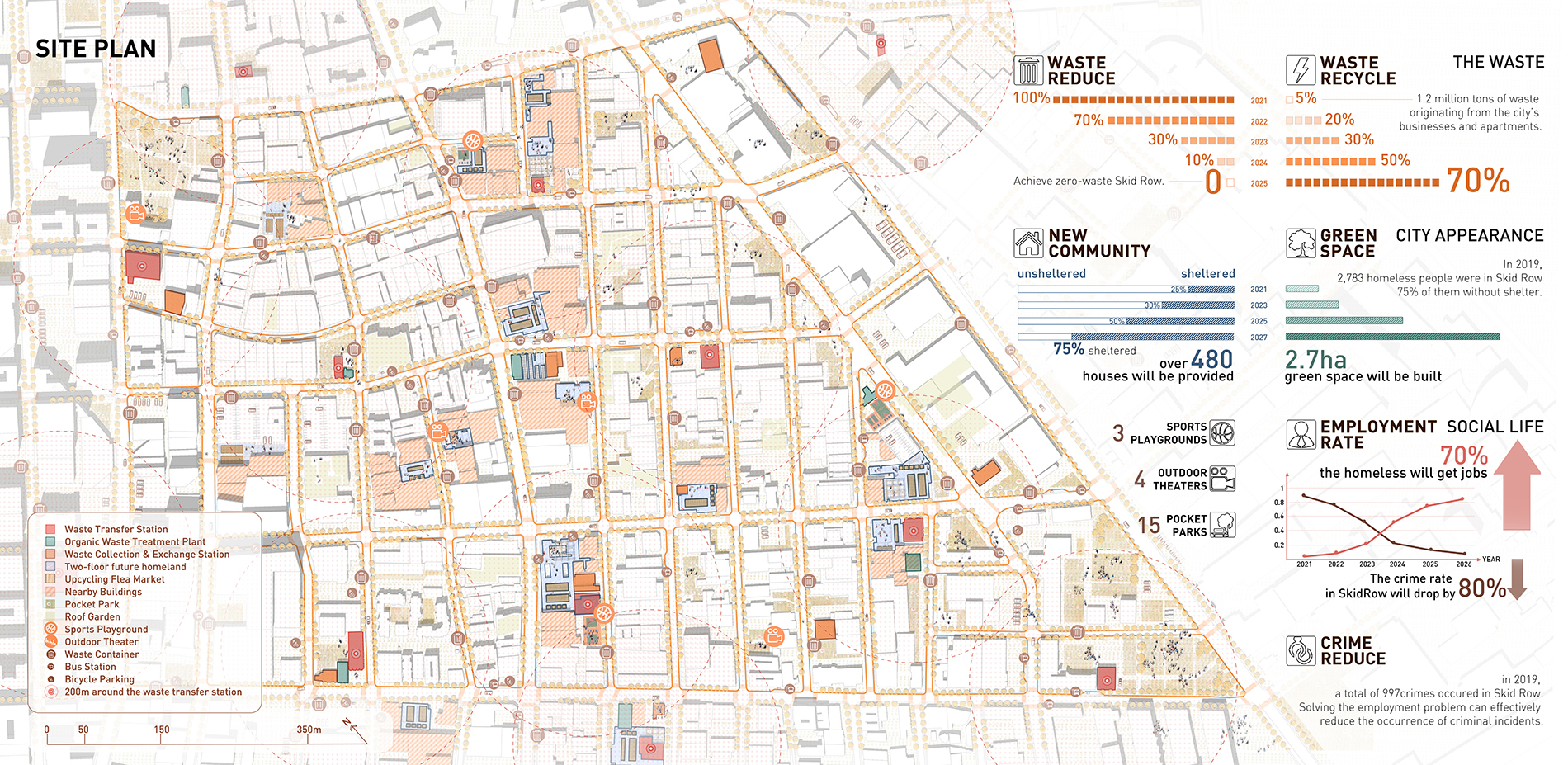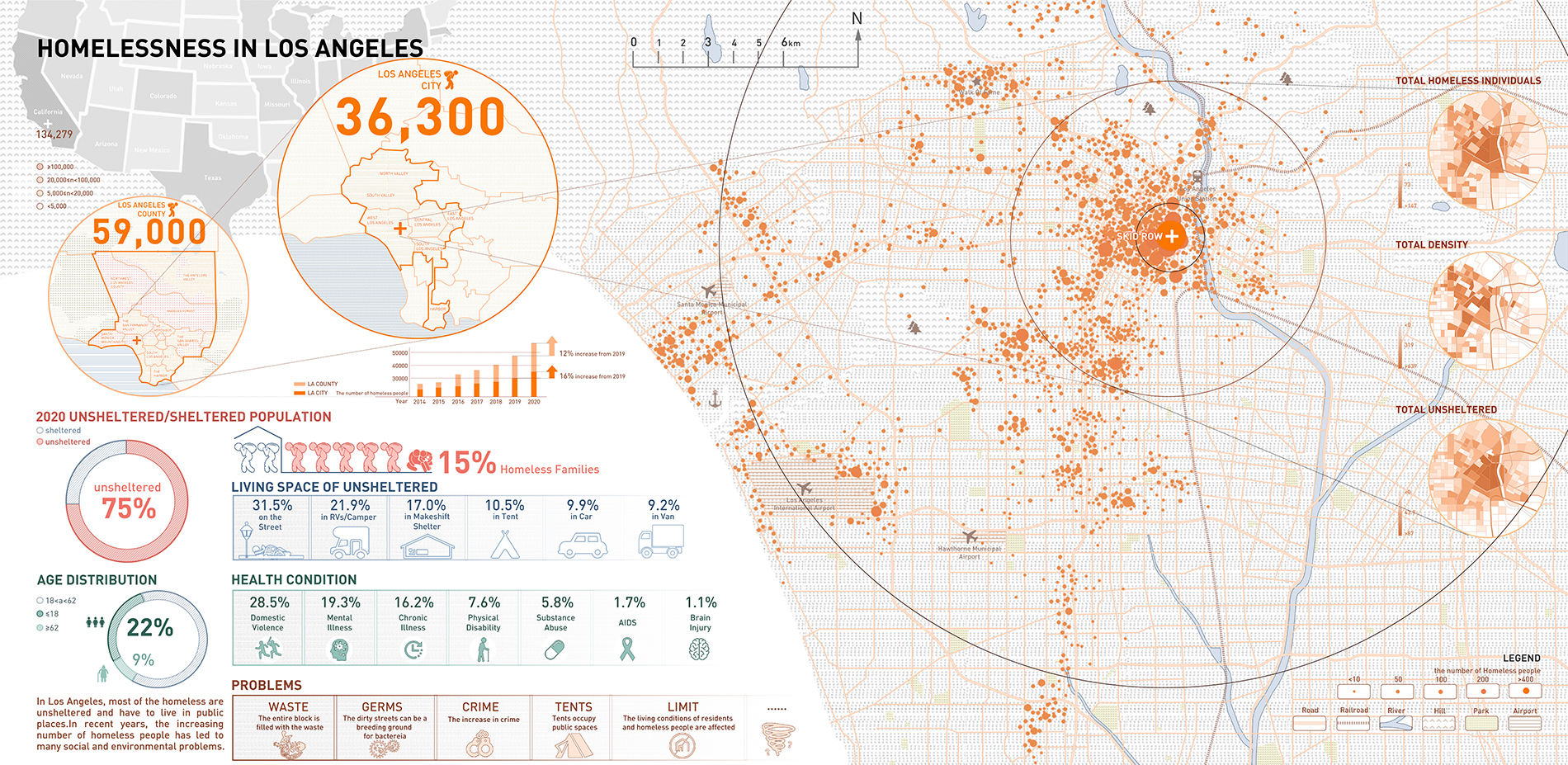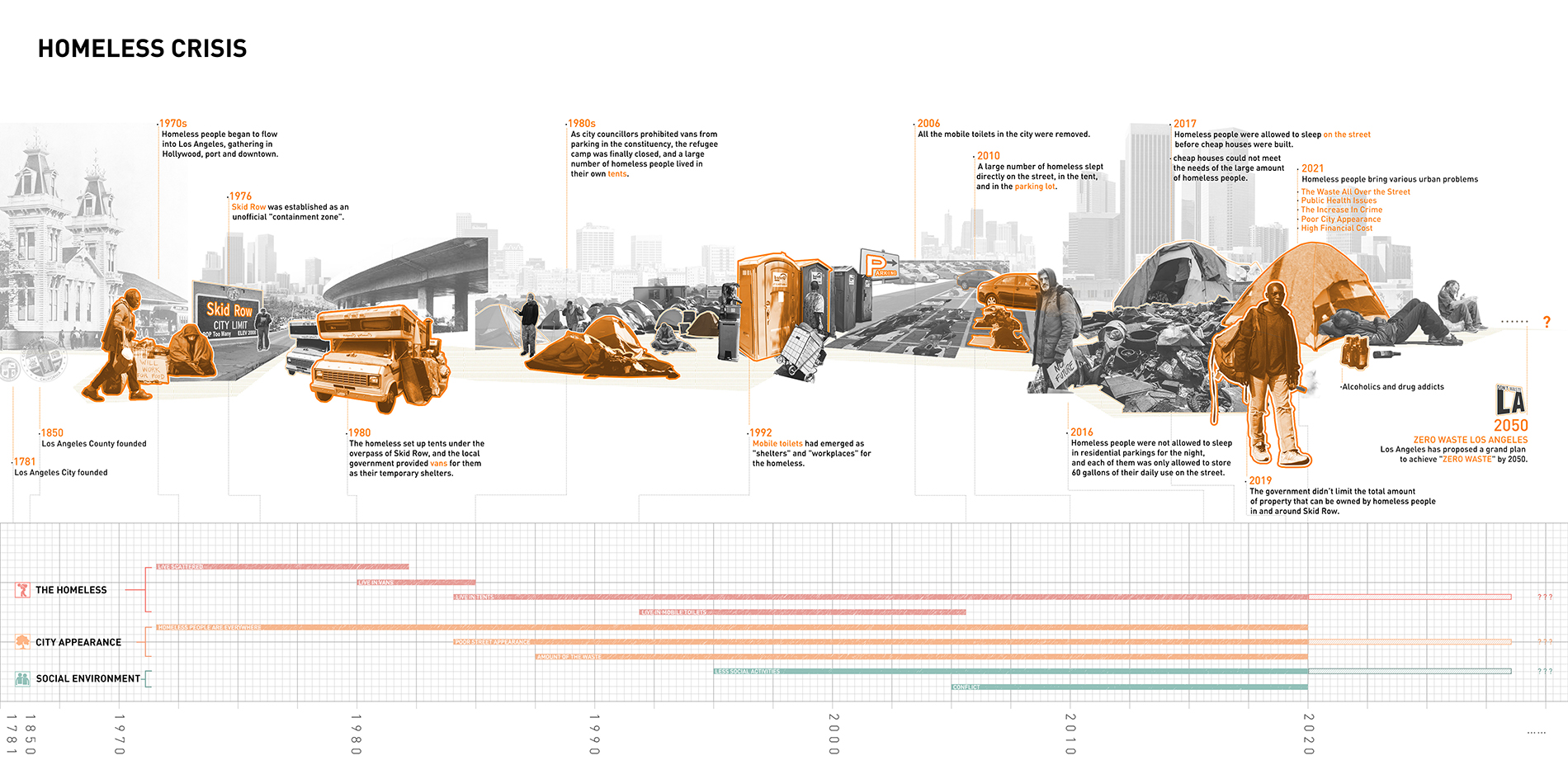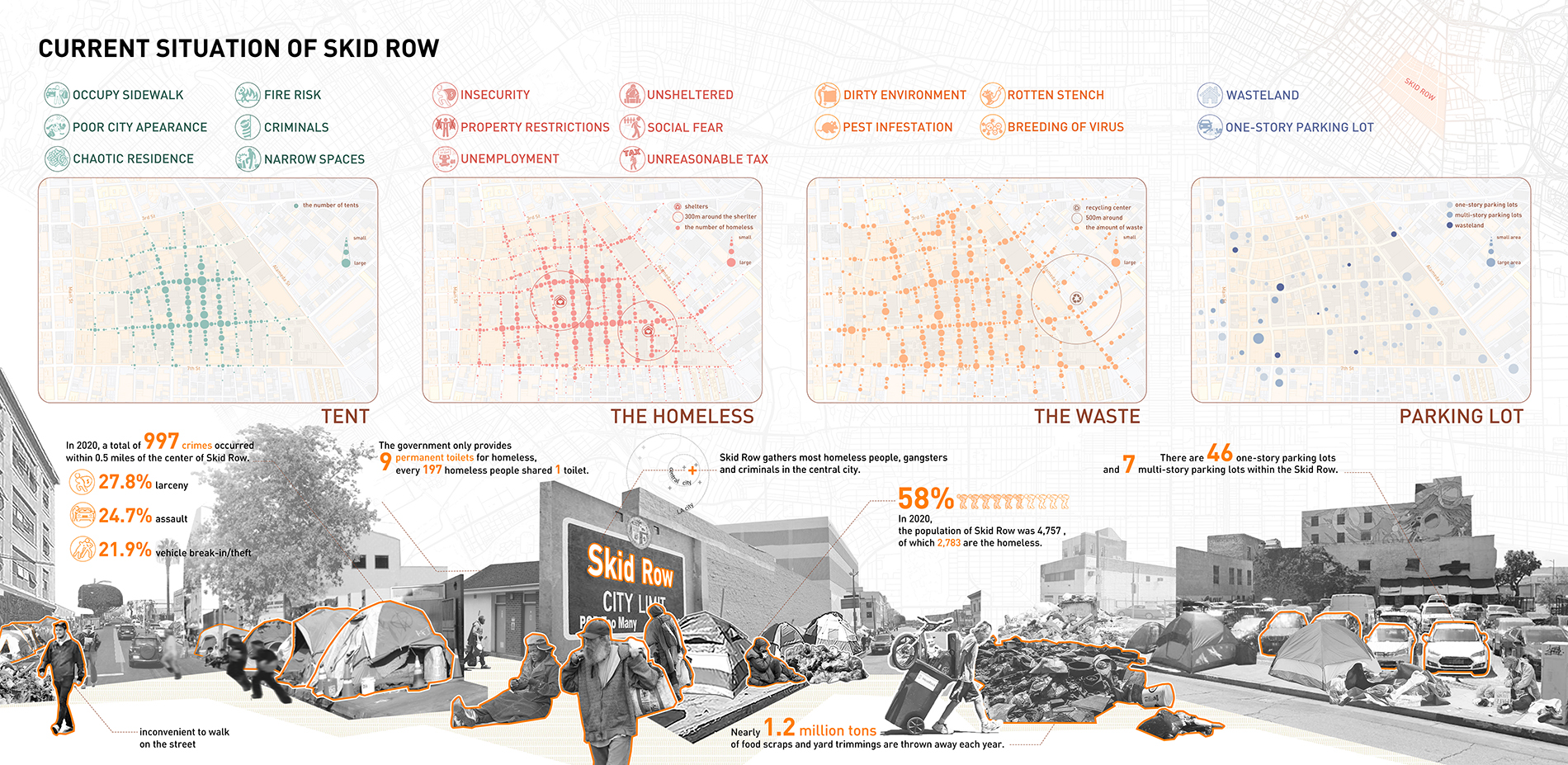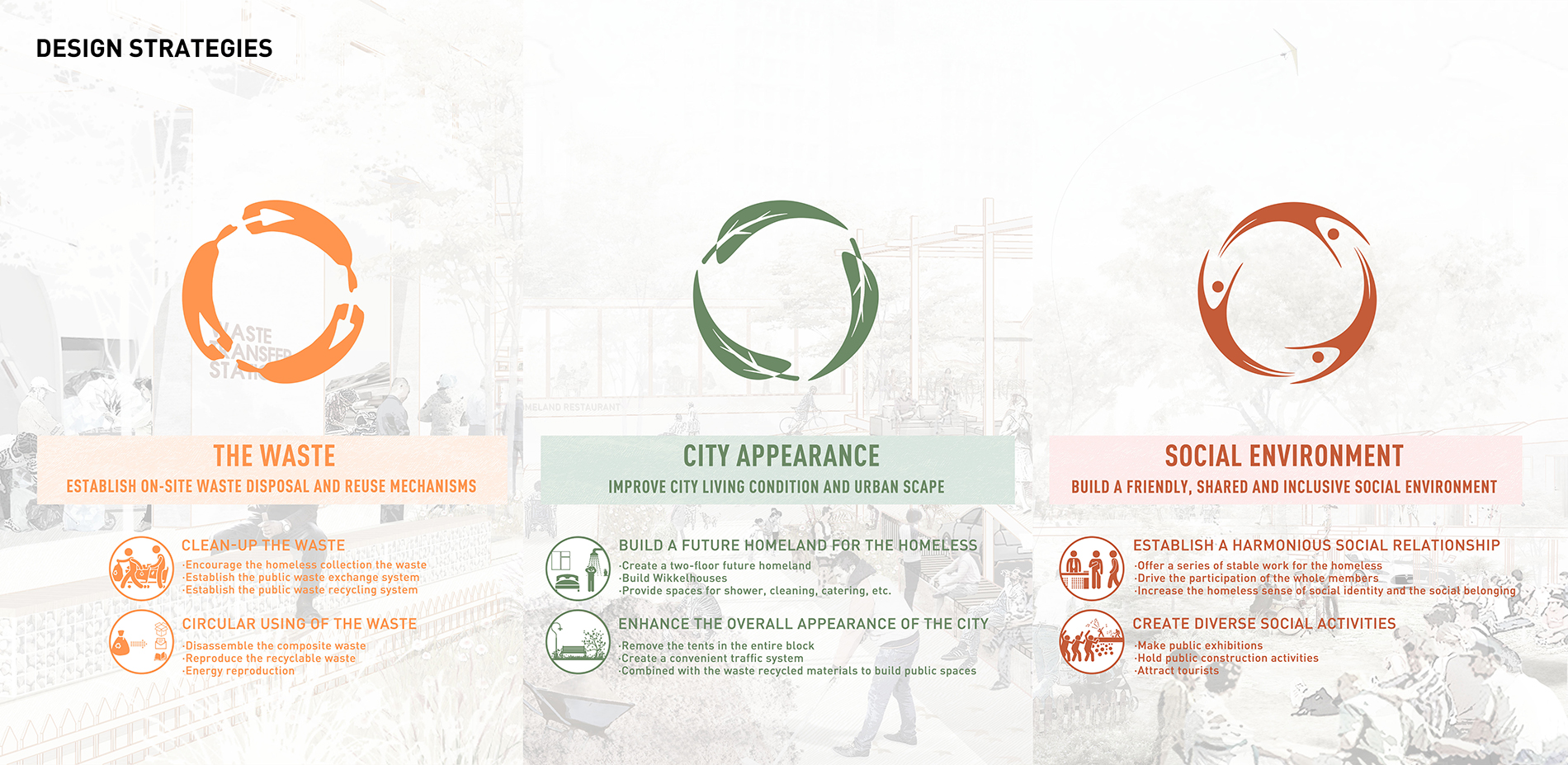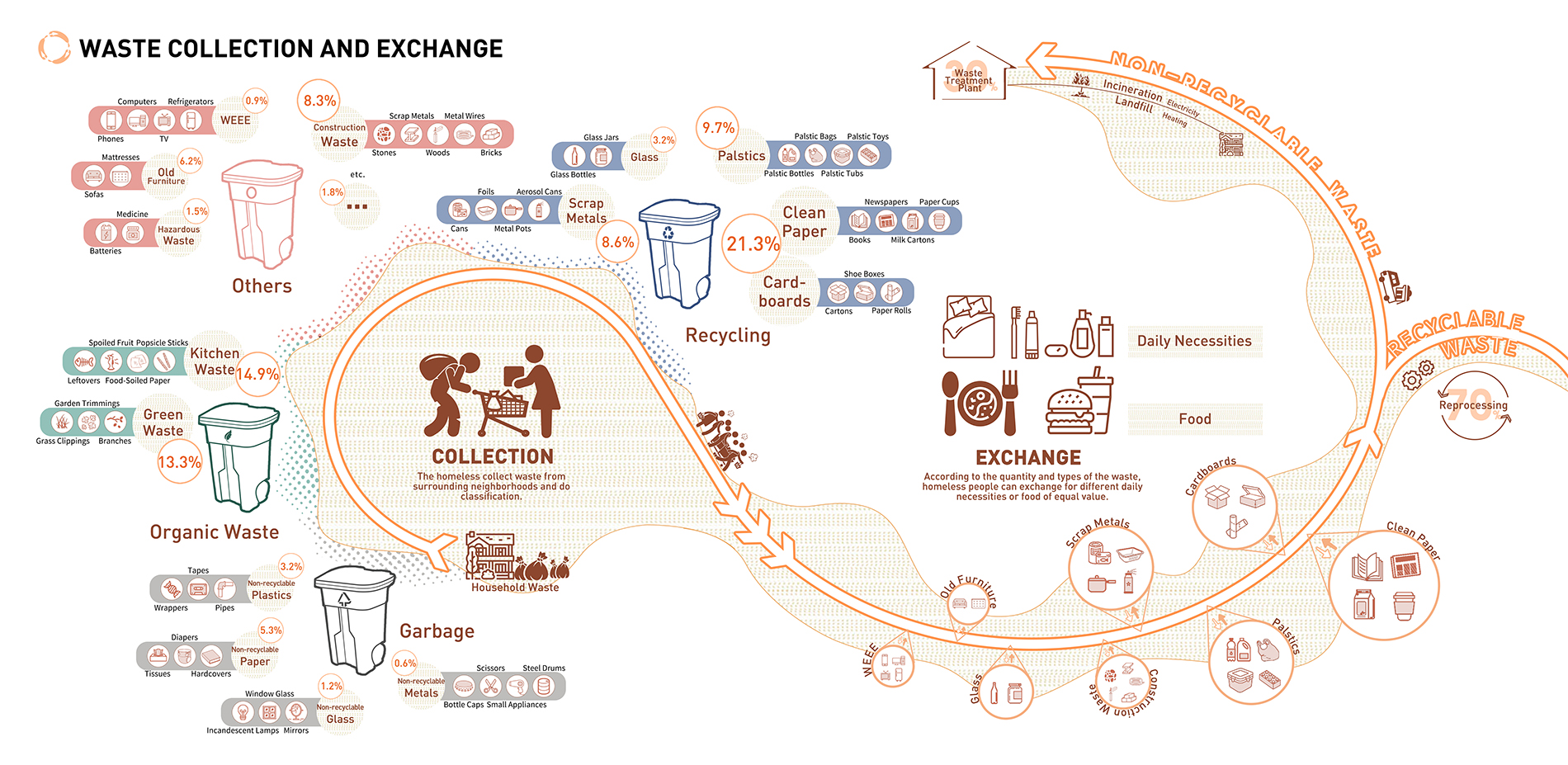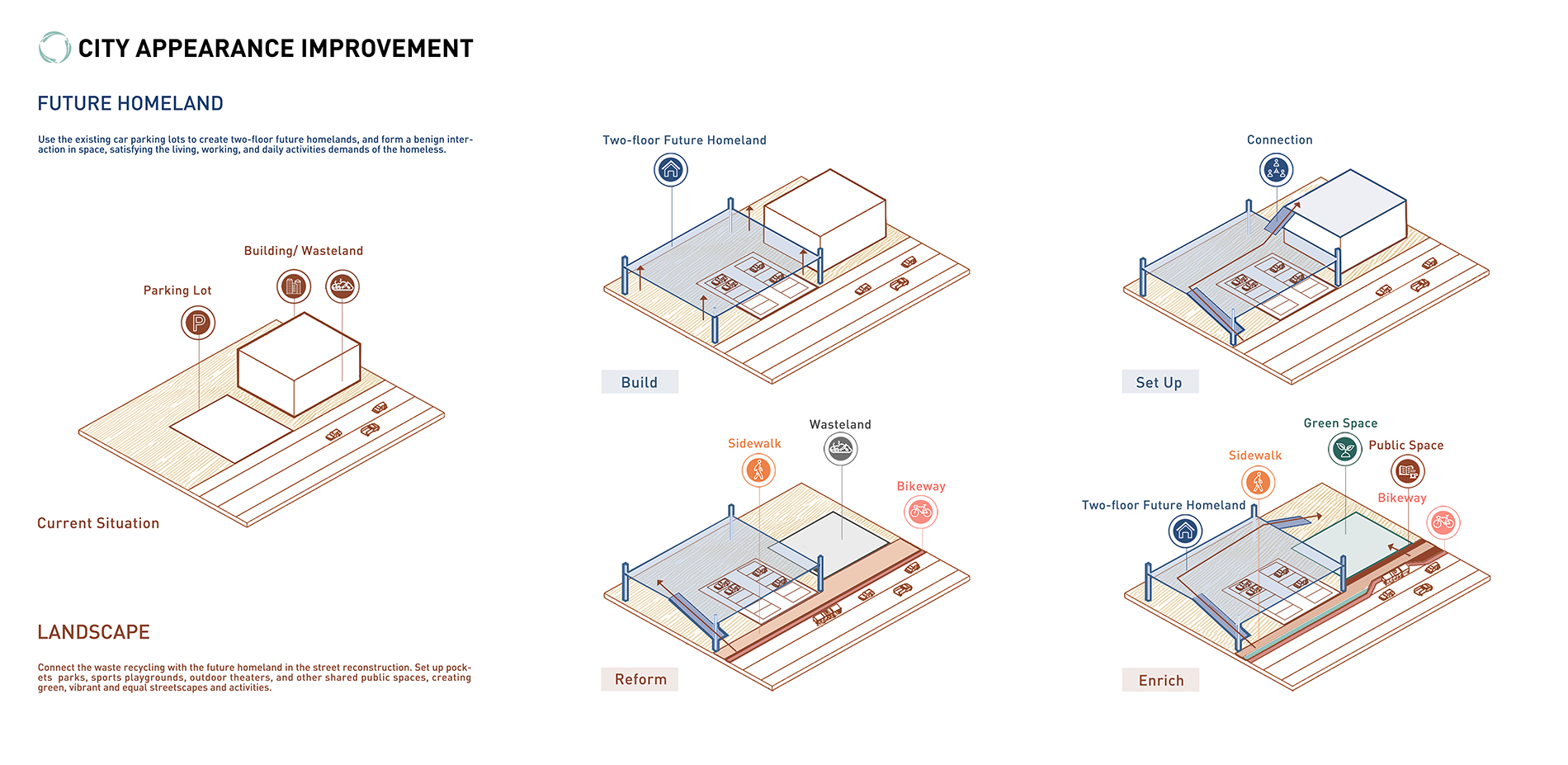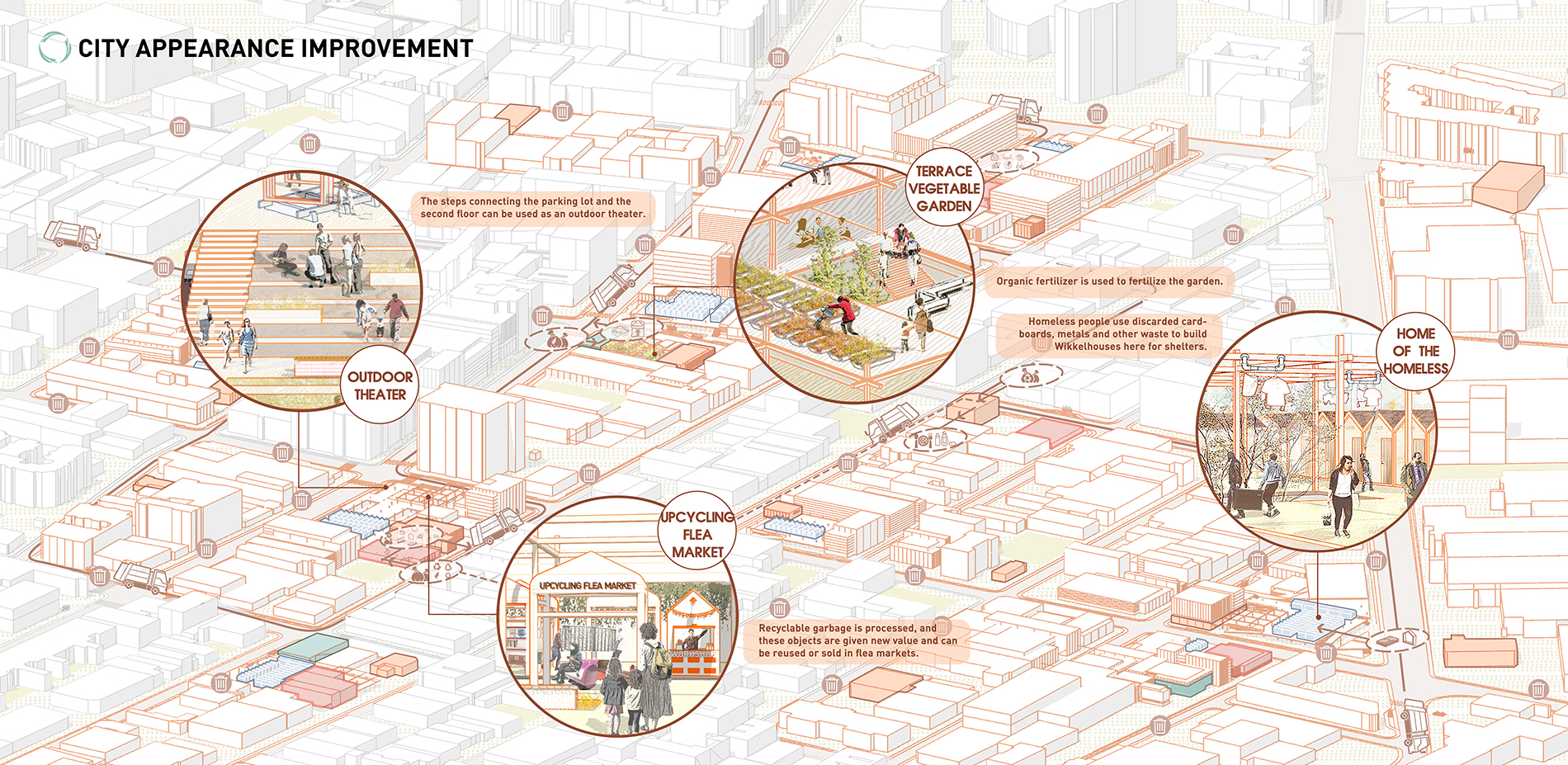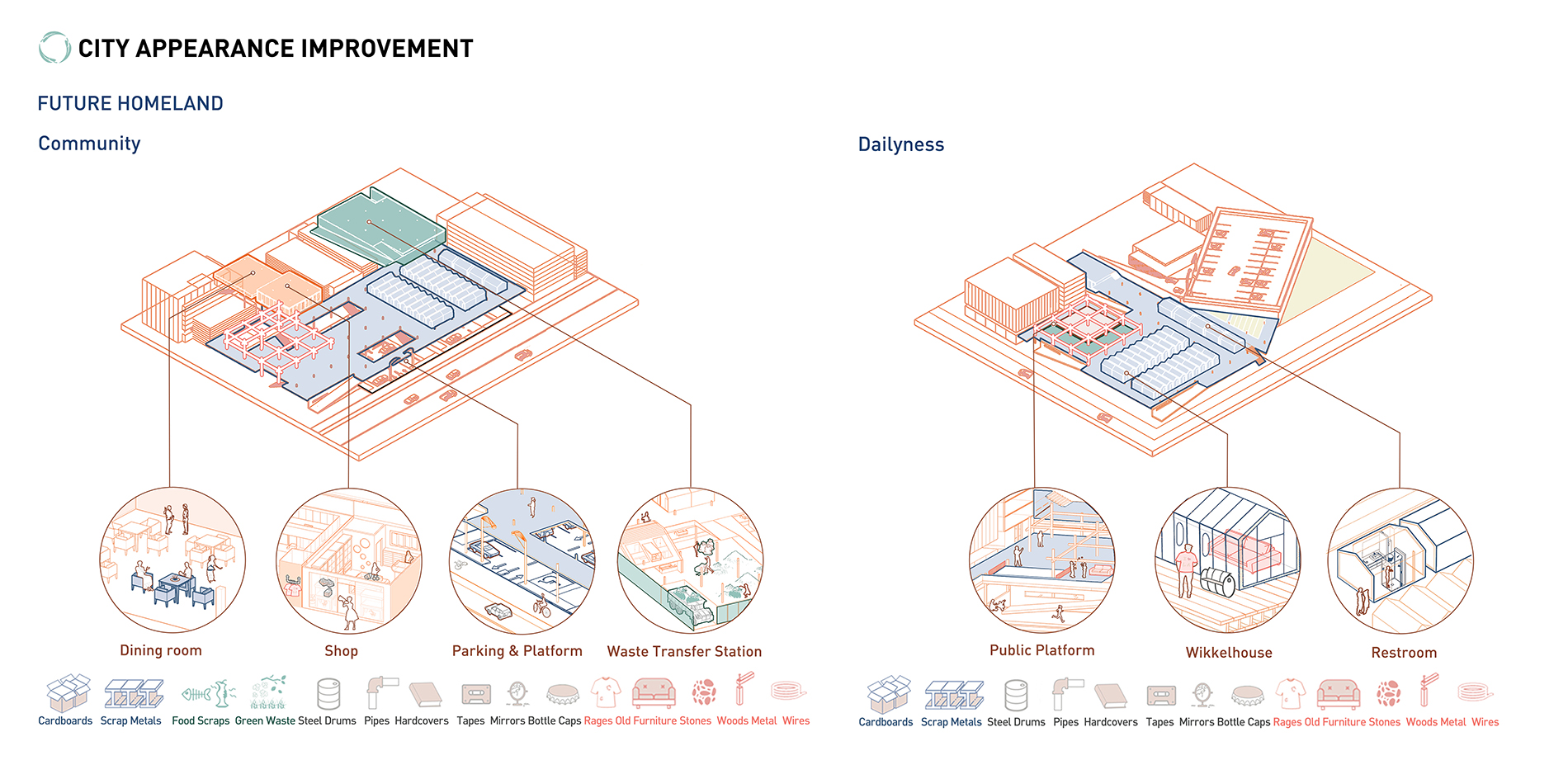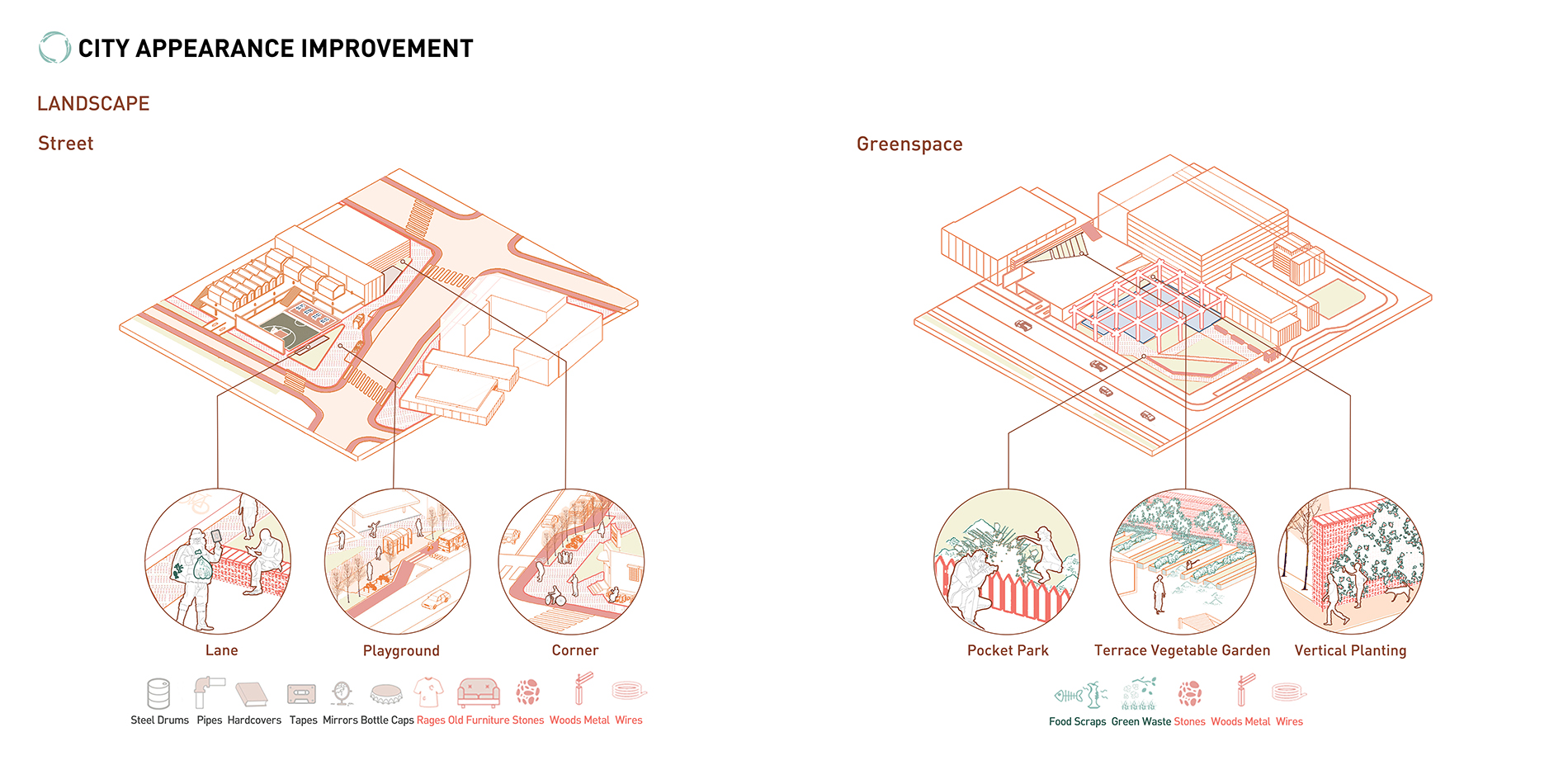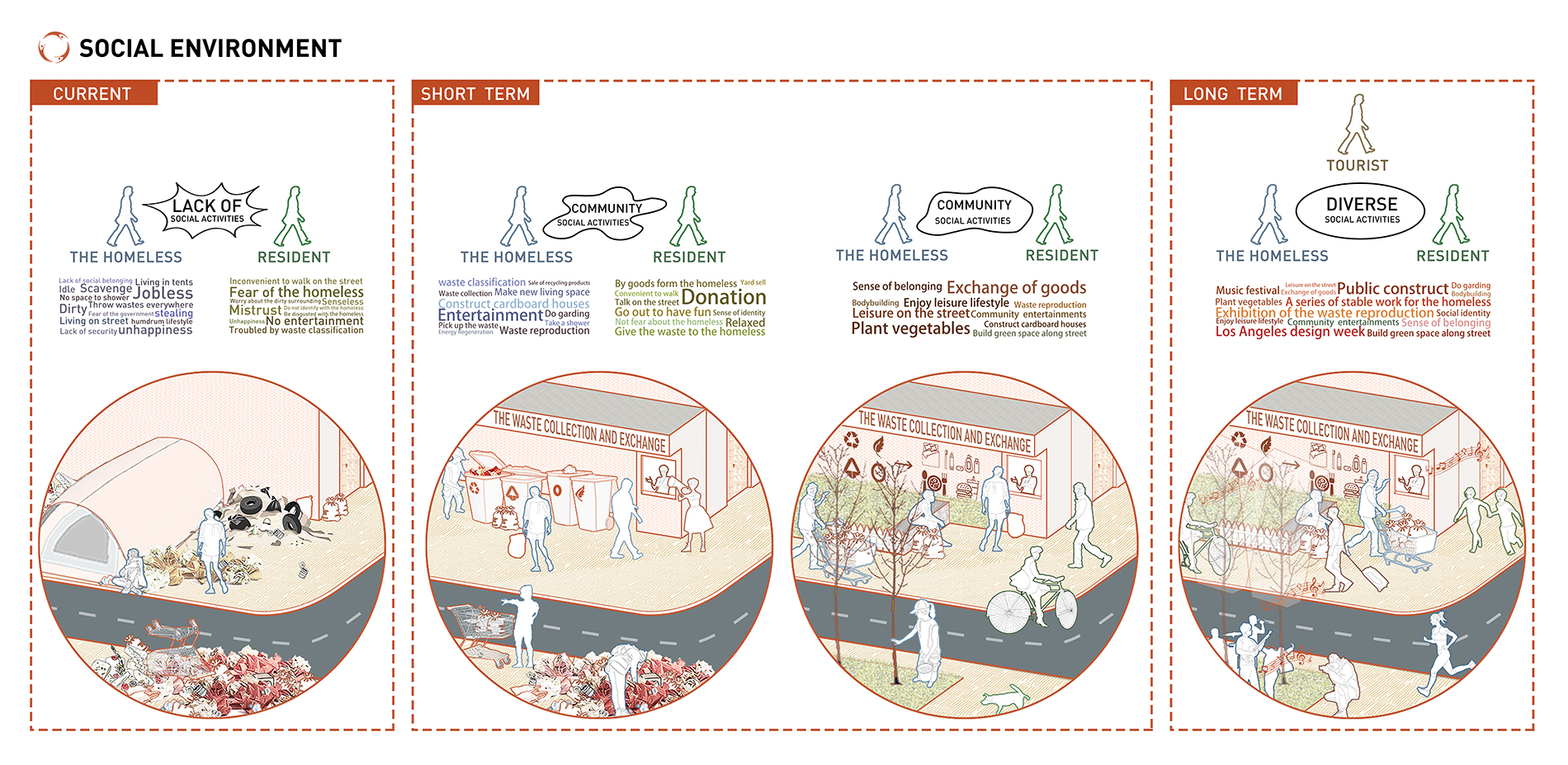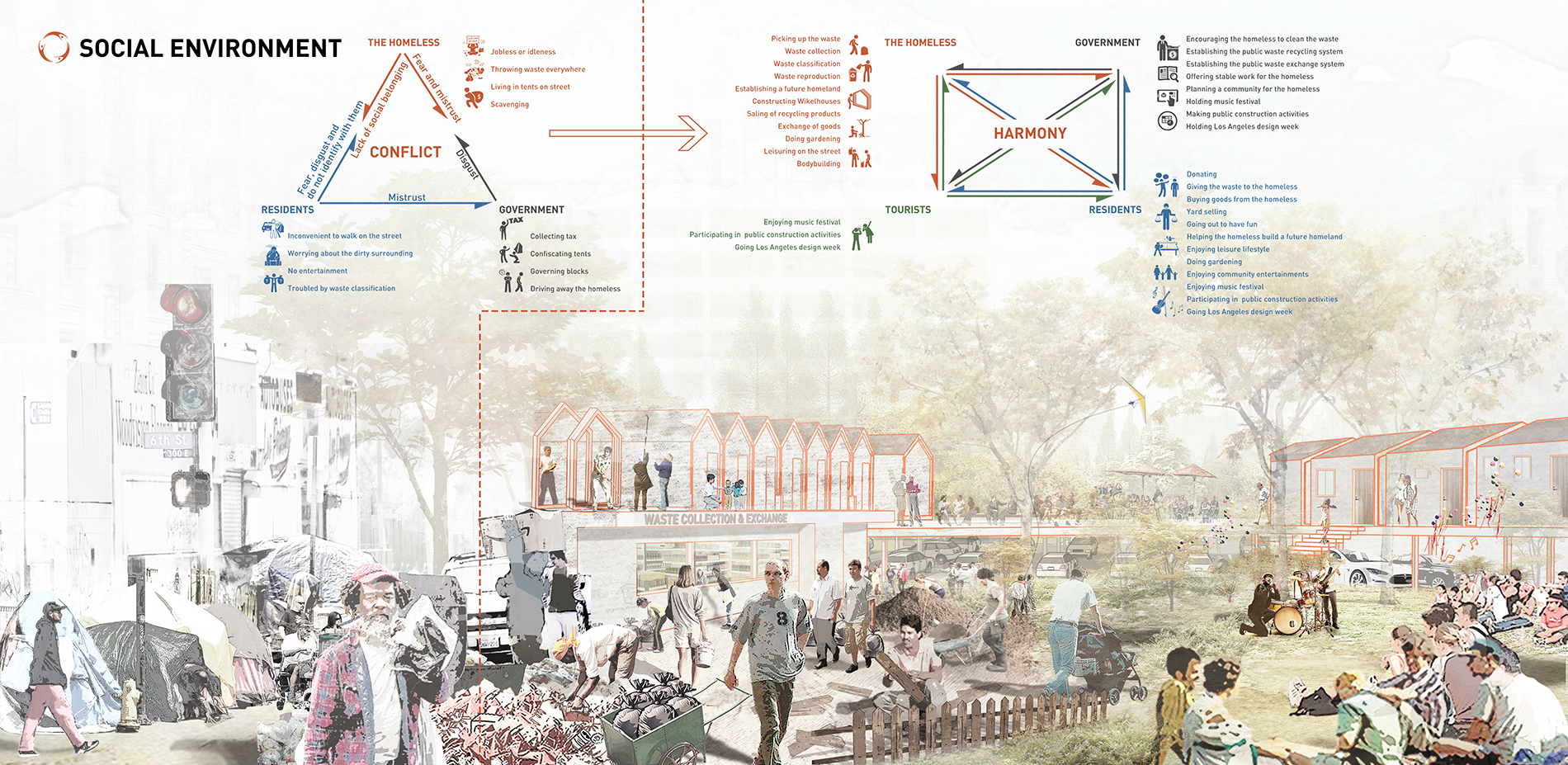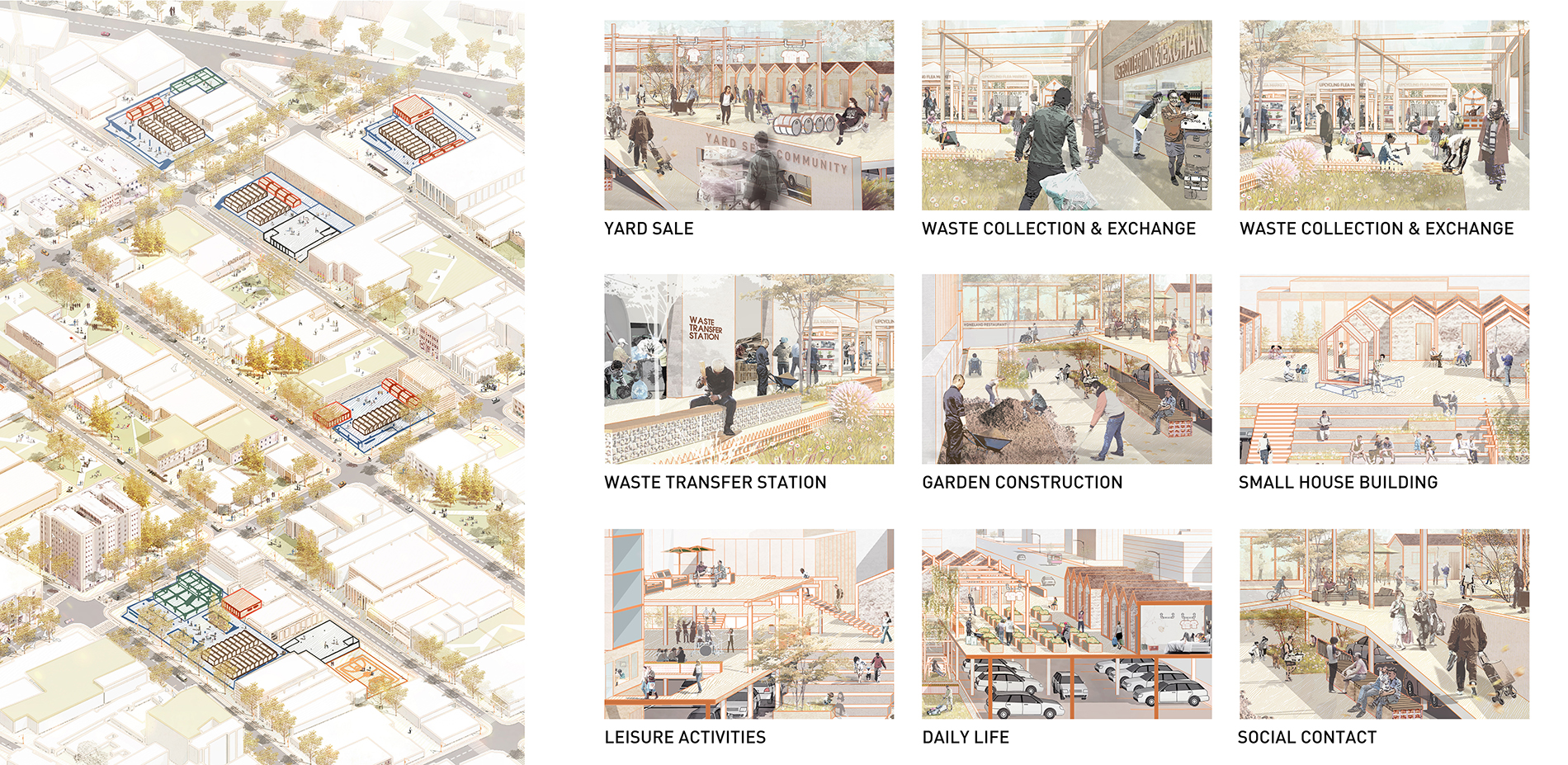Landscape Architecture Solutions for Rehousing the Homeless and Optimizing Waste Streams
Award of Excellence
Urban Design
Los Angeles, California, United States
Chao Zhou, Student International ASLA; Yangjin Jiang, Student International ASLA; Lyuyuan Jia, Student International ASLA; Leixi Qian, Student International ASLA; Kexin Wang, Student International ASLA
Faculty Advisors: Lin Qing; Xiangrong Wang, ASLA
Beijing Forestry University
This project is clearly socially grounded in addressing the homeless population of Los Angeles. It has a very clearly developed understanding of the social environment—a critical part of this category—and strategically deploys a number of interventions based on that understanding. We appreciated the way that the team layered their understanding, mapping tent communities, parking lots, and waste management as unique ecosystems that allows them to tackle these unique challenges with well-executed designs.
- 2021 Awards Jury
Project Statement
Skid Row gathers a large number of homeless people, and the tents occupy the entire city blocks. These makeshift shelters for the city's homeless are now an almost permanent fixture of the city's landscape, with piles of waste among them, which leads to a huge negative impact on city appearance, residents' commuting, life security, public health and social relations. The governors have published a series of policies to make the city better, but there are no obvious effects.
The project establishes on-site waste disposal and reuse mechanisms, and builds the future homeland, trying to reuse the waste to create accommodation and reform public environment based on existing one-floor parking lot, wasteland, and surrounding buildings. These strategies respond to the problems of tents occupation and waste dumping ingeniously, which also replies to 'zero waste Los Angeles'. In the meanwhile, it provides homeless people with dwellings and job opportunities, restore regional landscapes, and create a benign cycle of diverse social activities to reshape healthy, balanced and sustainable development for urban landscape and social relations sustainably.
Project Narrative
BACKGROUND
Starting in 1970, a large number of homeless people began to appear in Los Angeles. The number of the homeless has continued to grow significantly, reaching 36,300 in 2020, accounting for 61.5% of Los Angeles Counties' population. The city center Skid Row is one of the largest homeless gathering places in the United States. They set up tents in the streets and occupy a large number of free parking lots or other public spaces, which has seriously spoiled the cityscape and brought more crimes. Local government officials have been working hard to balance the homelessness issues with urban development needs. For example, the street sweeping operation started in February 1987; the Homeless Property Restriction Regulations in 2016, hoping to reduce the number of street homeless people; in 2017, a tax of $4.6 billion was levied to build houses (10,000 houses can be built within ten years), supporting the homeless; 'LIFT Act' provides up to $6,000 tax credits for low- income working families; May 2018 'Permanent Supporting Housing Regulations' took effect, shortening the time for homeless people to get housing. However, the various measures did not achieve the expected results, and even exacerbated the homeless' fearing of the governors, uncompromising of residence policy rules, and mistrusting of the government. Today's Skid Row is not only covered with tents, but also surrounded by waste, which causes more commuting, health, and security problems for local residents. Combined with the perennial heat and humidity of Los Angeles, the rapid growth of germs has become a major threat to the regional environment and public health, which further aggravating the conflicts between homeless people, residents and governments.
Los Angeles Mayor Eric Garcetti and the Los Angeles City Council approved the 'The Zero Waste LA franchise policy' system in April 2014. According to the 2015 report of the New Economic Alliance of Los Angeles (LAANE), local residents produce more than 1 million tons of waste every year, and as early as 2016, the space of the landfill in Los Angeles was almost exhausted, which caused waste management problems for the entire area. In 2019, the government proposed the idea of 'Pedestrian Priority Design', '360 Degree Design' and 'Climate Change Design' in the 'Citywide Design Guide', aiming for the actively, comfortably and safely participation in streets and public space activities for everyone.
69% of the homeless in Skid Row are 18-62 years old, most of them are mentally normal and have a certain ability to work. The main reason for their wandering is the lack of skills or ways to re-enter society and the difficulty of getting rid of poverty. It's obvious that the living environment of homeless people and the problem of street waste jointly limit the development of regional public health, environmental landscapes and social relations. The project believes that the response to the complex problems should be effective both in the near future and long-term. That is to establish on-site waste disposal and reuse mechanisms, improve city living condition and urban scape, offer a series of stable work for the homeless, thereby reshape a healthy, balanced and sustainable development for urban landscape and social relations.
STRATEGIES
1. Establish an on-site waste disposal and reuse mechanism. It is expected that the waste recycling rate in Skid Row will reach 70% by 2022, and achieve zero- waste block in 2025.
Establish local waste transfer stations, where the service radius of each transfer station is 200m, in conjunction with the 'zero Waste LA franchise policy' system, the homeless will send the waste around Skid Row and nearby area to the waste transfer stations for detailed classification. The waste will be divided into recycling, organic waste, garbage and others. Among them, recyclable or reusable waste will be processed and processed on-site in the block, and the remaining waste will be sent to the urban waste treatment plants for unified incineration or landfill. In this process, according to the quantity and types of the waste, the homeless can exchange for different daily necessities or food of equal value.
Recyclable waste is processed, and these objects will have new value and can be reused or sold. In this process, homeless people have various forms of participation, including sorting out the waste, and picking out the waste that can be processed and reused; folding the recyclable cardboard, assembling it with metal accessories, and building small houses for themselves; cleaning and repairing old furniture, renovating and using it; using organic soil formed by aerobic fermentation of organic waste to fertilize landscaping; transforming waste products into reselling handcraft artworks; processing construction waste into other construction materials, and etc.
2. Build a future homeland, improve the urban environment, and enhance the overall appearance of the city. By 2023, there will be no homeless people sleeping on streets in Skid Row. In 2027, 2.7ha greenspaces and public spaces will provide numerous activities for all citizens, such as sports, recreations, and entertainments.
Use the existing one-floor parking lots, open spaces and the surrounding buildings to create the two-floor future homeland and form a benign interaction in space. Future homelands include Wikkelhouses, restrooms, recycling workshops, dining rooms, shops, terrace vegetable gardens, which satisfy the living, working, and daily activities demands of the homeless, and create a healthy, equal, and sufficient living environment. In the process of community construction, there are homeless people participating. In their living environment, they will use a lot of products obtained from recycling and transformation the waste, which is very participatory, autonomous and interesting.
Reconstruct streets and public spaces based on the status quo to enrich the streetscape and public activities. In the street reconstruction, the waste recycling would be fully as well as the street furniture, fertilizers, artworks, etc., connecting with the future homeland to form a community-greenspace-public activity space-walkway-cycling lane vehicle structure hierarchy and set up pocket parks, sports playgrounds, outdoor theaters, upcycling flea markets and other shared public spaces, creating green, vibrant and equal streetscapes and activities.
3. Offer stable work for the homeless who are conscientious, and form a friendly, shared and inclusive social environment.
In the process of waste recycling and the construction of future homeland, the participation of homeless people in social activities would change public's stereotype of them. Among them, short-term social activities are mainly street waste collection, collection of residents' waste and waste sorting, combined with the waste recycled materials to build public spaces, Wikkelhouses and various daily necessities to help improve the appearance of the city; after establishing a certain amount of public space, some public activities can be reformed to job opportunities for homeless people, such as waste sorting and recycling activities.
The sense of social identity and the social belonging of the homeless are greatly increased by participating in the recycling, building homeland and public construction. Such activities can promote the participation of all people, and attract tourists to experience the street culture of Skid Row and promote regional development. Eventually, a benign interactive relationship between the homeless, residents, government and tourists will be formed, and in the long-term, the street landscape and social relations that achieve healthy, balanced and sustainable development.
Responding to the problems of tents occupation and waste dumping, the project establishes on-site waste disposal and reuse mechanisms, and builds the future homeland, which will make joint effort to rehouse the waste and the homeless. Furthermore, it will provide homeless people with jobs. Los Angeles county is expected to achieve zero-waste by 2030. There will be no makeshift shelters on streets, and the homeless will have work to do, the crime rate will be reduced in the long run. The project will reshape a healthy, balanced and sustainable development for urban landscape and social relations sustainably.
Plant List:
- White alder
- California walnut
- Gold medallion
- Pink trumpet tree
- Chinese pistache
- California bay laurel
- Indian laurel
- Valley oak
- California fan palm
- Modesto ash
- Hollyleaf cherry
- Sugar bush
- California wild rose
- Toyon
- California sagebrush
- California buckwheat
- California goldenrod
- Pitcher sage
- California aster
- Common rush
- Agave
- Daisy
- Lettuce
- Kale
- Buffalo grass
- California bentgrass
- Morning glory
- Potato vine
- Cherry tomato
